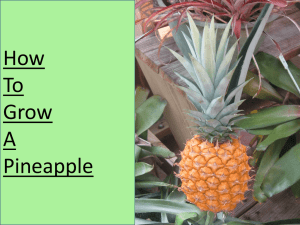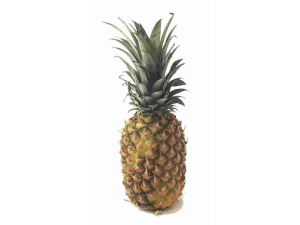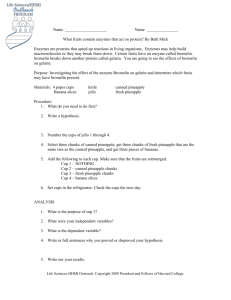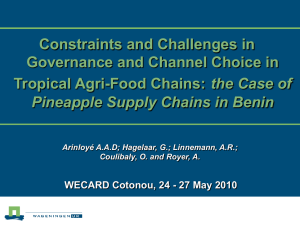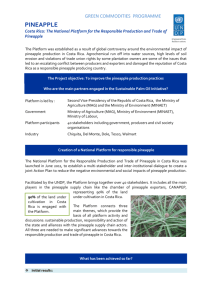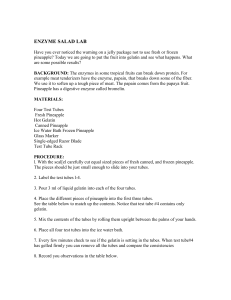PMCA Pineapple project final report
advertisement
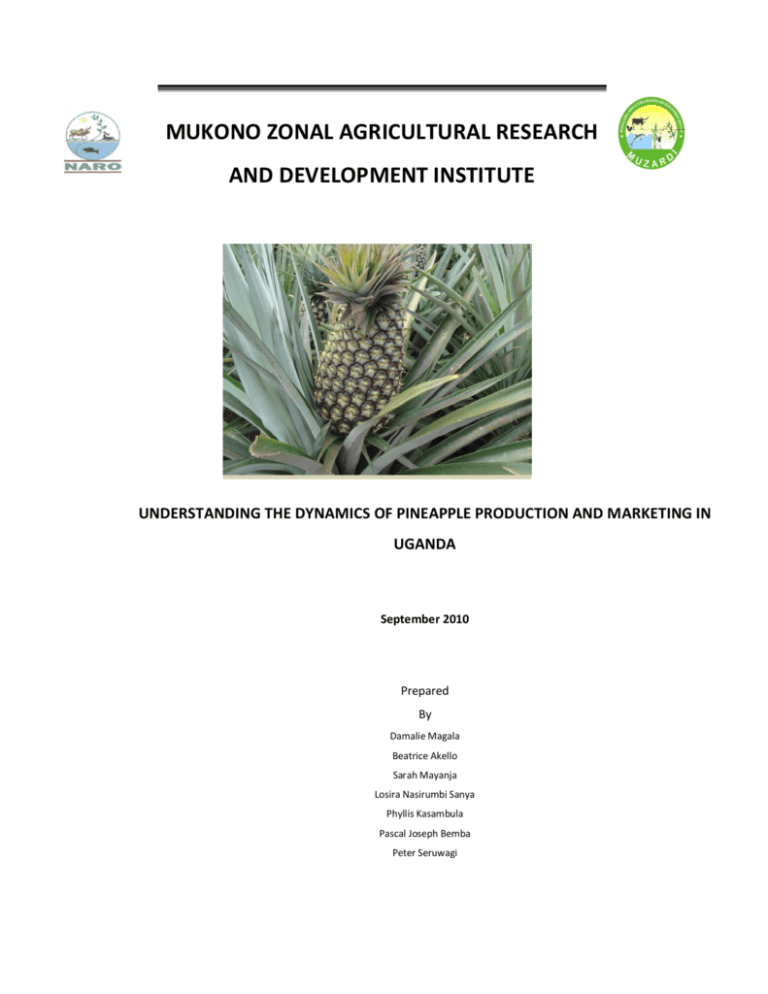
MUKONO ZONAL AGRICULTURAL RESEARCH AND DEVELOPMENT INSTITUTE UNDERSTANDING THE DYNAMICS OF PINEAPPLE PRODUCTION AND MARKETING IN UGANDA September 2010 Prepared By Damalie Magala Beatrice Akello Sarah Mayanja Losira Nasirumbi Sanya Phyllis Kasambula Pascal Joseph Bemba Peter Seruwagi ACKNOWLEDGMENT The study team would like to acknowledge and extend appreciation to all the key market players including pineapple farmers, traders, processors, Non-government Organizations, district officials, NAADS extension officials in Kampala, Iganga, Luwero and Bushenyi districts for providing such valuable information in this report. All MUZARDI research assistants who were involved in the data collection exercise are greatly cherished. Funding for this work was provided by National Agricultural Research Organisation (NARO) under the Competitive Grant Scheme. Special thanks go to the Director of Research Mukono ZARDI, Mr. Peter Lusembo for his continuous encouragement and guidance in carrying out this assignment. Pineapple Market Survey -PMCA Phase I Report 2 CONTENTS ABBREVIATIONS AND ACRONYMS ................................................................................................................II 1.0 INTRODUCTION AND BACKGROUND...............................................................................................1 2.0 METHODOLOGY...............................................................................................................................2 2.1 Review of available literature ...............................................................................................................2 2.2 Pineapple Market Chain Survey...........................................................................................................2 2.3 Definition of thematic groups ...............................................................................................................3 2.4 Final event..........................................................................................................................................3 3.0 MARKET CHAIN FINDINGS (ACTIVITIES, CONSTRAINTS AND OPPORTUNITIES ...........................4 3.1 Production of fresh pineapples in Uganda ............................................................................................4 3.2 Seed production ..................................................................................................................................9 3.3 Commercialization...............................................................................................................................9 3.4 Pineapple products and Processing ...................................................................................................10 3.5 Marketing and marketing channels ....................................................................................................13 3.6 Opportunities and constraints along the market chain .........................................................................18 3.6.2 Constraints ......................................................................................................................................18 4.0 CONCLUSIONS AND RECOMMENDATIONS ...................................................................................21 LIST OF RESPONDENTS ..............................................................................................................................22 REFERENCES...............................................................................................................................................24 Pineapple Market Survey -PMCA Phase I Report i ABBREVIATIONS AND ACRONYMS A2N Africa 2000 Network BDLG Bushenyi District Local Government BUDIFA Bushenyi District Farmers’ Association DFID Department for International Development. DSIP Development Strategy and Investment Plan JICA Japan International Cooperation Agency HPOU Horticultural Promotional Organization of Uganda HORTEXA Horticultural Exporters Association LUDIFA Luwero District Farmers’ Association NARO National Agricultural Research Organisation MUZARDI Mukono Zonal Agricultural Research and Development Institute MAAIF Ministry of Agriculture, Animal Industry and Fisheries NAADS National Agricultural Advisory Services NaCRRI National Crop Resources Research Institute NOGAMU National Organic Agricultural Movement of Uganda PMCA Participatory Market Chain Approach UEPB Uganda Export Promotion Board PRAPACE Regional Potato and Sweet Potato Improvement Network in Eastern and Central Africa UNBS The Uganda National Bureau of Standards UIRI Uganda Industrial Research Institute VEDCO Volunteer Efforts for Development Concerns Pineapple Market Survey -PMCA Phase I Report ii 1.0 INTRODUCTION AND BACKGROUND NARO-Mukono Zonal Agricultural Research and Development Institute (Mukono ZARDI) is implementing the ‘Understanding the dynamics of pineapple production and marketing in Uganda’ project in collaboration with three partner organizations. These organizations are National Crop Resources Research Institute (NaCRRI), Agri-net Uganda Ltd and Volunteer Efforts for Development Concerns (VEDCO). The overall objective of the project is to enhance collaboration among R&D actors and market chain actors to jointly improve the competitiveness of the pineapple sub-sector sector.The project is based on a qualitative action research approach, where opinions from different stakeholders are discussed and consolidated in a participatory framework. The methodology used is based on the principles of Participatory Market Chain Approach (PMCA). PMCA is a research and development method involving different actors of market chains. The approach seeks to generate group innovations in a participatory process that stimulates interest, trust and collaboration amongst members of the market chain. The Approach further seeks to generate group innovations by identifying and implementing viable market opportunities. . It follows a three step generic process which (1) identifies (2) analyzes and (3) implements the most appropriate innovations along the chain. PMCA was tried and tested with reasonable success in the Andes, which resulted in better innovations and market opportunities for small-scale potato farmers, and other actors in the market chain. Following the successful interventions in the Andes, PMCA was introduced in Uganda by the Papa Andina Initiative and PRAPACE with DFID funding. The first applications of PMCA in Uganda on Sweet potato, Solanum potato and vegetables (hot pepper and tomato) proved that the methodology is useful for building multi-stakeholder platforms and generating pro-poor innovations. A subsequent project was therefore proposed to enhance the productivity and marketability of pineapple using the PMCA. This report outlines the activities, findings and outcomes of applying the PMCA approach (Phase 1) to the Pineapple sub-sector in Uganda. The major outcomes include: i. Better understanding of the pineapple sub-sector upon identification of major actors along the chain, their activities, interests and constraints. ii. Generated interest as a result of interaction amongst the market chain actors in the final event. iii. Identification and formation of 2 thematic groups along potential innovation lines. Pineapple Market Survey -PMCA Phase I Report 1 iv. Increased awareness of PMCA to a wider audience. 2.0 METHODOLOGY During the period July- September 2010, the three leading institutions implemented the first phase of PMCA on the pineapple sub-sector in Uganda. The main activities included; a. Review of available literature b. Preparation and planning for the survey c. Development and pre-testing survey instruments d. Conducting the survey e. Data analysis and identification of thematic groups f. 2.1 Planning and holding the final event Review of available literature A literature review was carried out to obtain available and relevant information on what has been done at national and district level (i.e. proposed operational areas). To get updated statistical figures and strategies, on electronic search was done to obtain information on pineapple production and marketing worldwide, at regional and nation al levels. Such documents included investments reports, MAAIF DSIP (2009 -13) as well as in the National Development Plan (2010 -14), Uganda Export Promotion Board documents and district profiles. 2.2 Pineapple Market Chain Survey The study team carried out a rapid market survey, on the pineapple sub-sector in Bushenyi, Iganga, Luwero and Kampala districts. The main objective of conducting the survey was to identify the major key market players in the pineapple sub-sector chain, understand their activities, challenges and solutions to these problems. PMCA tools were used to identify major actors in the market chain, their activities, inputs, outputs, level of governance in the chain, collaboration within the chain, problems encountered as well as possible solutions and innovations along the chain. Checklists for different categories were developed to guide the interviews. Face-to-face interviews were held with different market chain actors including processors, producers, traders (retailers, wholesalers and bicycle assemblers) and research and development institutions. Altogether, the team interacted with 131 persons. Details of the findings are provided in the next chapter. Pineapple Market Survey -PMCA Phase I Report 2 2.3 Definition of thematic groups Survey data was analyzed and synthesized to identify possible thematic areas for further discussions at the final event. Two thematic groups were formed at the final event i.e. fresh pineapple and processed pineapple group. The groups will create platforms for participants to evaluate and fine tune concrete market options for Uganda pineapples. 2.4 Final event In light of the survey findings, key respondents were invited to participate in the final event, which was held at NARO- Mukono ZARDI, in Mukono district. A total of 70 participants attended the function. During the meeting, survey findings were presented and participants made positive comments to enrich the findings. Basing on the ideas of different actors on possible marketing opportunities, two broad thematic areas for future action were identified i.e. fresh pineapples and processed pineapples. Pineapple Market Survey -PMCA Phase I Report 3 3.0 MARKET CHAIN FINDINGS (ACTIVITIES, CONSTRAINTS AND OPPORTUNITIES) 3.1 Production of fresh pineapples in Uganda At global level, Pineapple is the second harvest of importance after bananas, contributing to over 20 % of the world production of tropical fruits (Coveca, 2002). Pineapple production in Uganda has no clearly documented history. What is known is that the crop has traditionally been grown for home consumption until the last two decades when the fruit assumed commercial importance in Luwero and Kayunga districts. It is now by far the most widely grown fruit in Uganda. Current Pineapple production is estimated at 190Ha and 1,600MT mainly in 2,500 smallholdings of Luwero and Kayunga as shown in Table 1. Given the favorable climatic conditions, Uganda still registers low production level of the crop compared to other east African countries. In most production areas, pineapples are grown as a sole crop or intercropped with bananas. In Uganda, there are no large scale pineapple growers at the moment and pineapples are produced exclusively as a smallholder crop. Available literature shows there a high level of participation of small-holder farmers in the production process. The total number of organic farmers has increased from 15,000 in 2001/3 to 206,803 in 2007/08 (NOGAMU). Varieties of pineapples grown currently include: the small sized spiked (Sasilimu) also known as ‘Queen Victoria’ variety and the large smooth Cayenne (smooth, spineless leaves). However, farmers generally prefer the smooth cayenne which allows ratoon cropping, is larger and juicier while Queen Victoria gives one fruit in its life time and the farmer has to cut back or replant after each harvesting cycle (UIA, 2009). Pineapples prefer well drained sandy loam soils with high organic matter content and a pH between 4.5 and 6.5. In Uganda, particularly in Kayunga, Luwero and Kasese districts the climate is favorable for planting at any time. Irrigation has the added advantage of planting any time, early maturity and harvesting through out the year. Pineapple Market Survey -PMCA Phase I Report 4 Table 1. Pineapple production trends in East African Countries Country Kenya Uganda Tanzania Rwanda Year 2005 2006 2007 2008 Area harvested (Ha) 14,500 15,123 14,271 14,271 Yield Hg/Ha) 413,793 276,307 300,655 300,655 Production (MT) 600,000 417,860 429,065 429,065 Area harvested (Ha) 194 190 190 190 Yield Hg/Ha) 85,051 84,210 84,210 84,210 Production (MT) 1650 1600 1600 1600 Area harvested (Ha) 9,000 9,000 9,000 9,000 Yield Hg/Ha) 86,666 86,666 86,666 86,666 Production (MT) 78,000 78,000 78,000 78,000 Area harvested (Ha) 1,600 1,750 1,850 1,961 Yield Hg/Ha) 93,750 91,428 91,891 92,850 Production (MT) 15,000 16,000 17,000 18,208 Source: FAO Statistics Division, 2010 3.1.1 An over view of pineapple production in survey districts Bushenyi In Bushenyi, pineapples were grown alongside with tea, banana, coffee and dairy farming in Kyamuhunga and Nyarubaale sub-counties with an estimated acreage of 1000Ha (BDLG 2004). Farmers mainly re-cycled planting materials for smooth cayenne. Apart from NAADS, the district had no other collaborators and promoters of pineapple production. Bushenyi District Farmers’ Association (BUDIFA) was active during the period of 1998-2005, but most its groups now belong to NAADS. There were no NGO’s involved in agricultural production largely because the Bushenyi. But all pineapple stakeholders in the district noted an increasing trend in the production and demand of pineapples both within and outside the district. Collaboration with other organizations like Uganda Investment Authority, Uganda Industrial Research Institute, Ministry of Tourism Trade and Industry, Uganda National Bureau of Standards and One village One Product-JICA project was noted in the district. Pineapples were sold locally to individual traders within and outside the district and roadside markets. Most traders who bought Bushenyi fresh pineapples came from Kampala, while others were from Rukungiri and Kasese districts. A few if any pineapples were sold to neighboring districts of Mbarara and Masaka districts. Schools and tertiary institutions were the major consumers within the district. Pineapple Market Survey -PMCA Phase I Report 5 Regional and cross-border trade was reported as well but no concrete information was given on the final destination of the commodity beyond Sudan, Congo and Rwanda borders. In terms of processing, Bushenyi District Local Government tried to support farmers to add value to pineapple in form of solar drying. One farmer was exporting solar dry chips to German through Fruits of the Nile but was currently out of production due to structural problems at Fruits of the Nile (FON). Bushenyi pineapples were known to be more acidic compared to those from other production areas. This may be attributed to a higher altitude of the area among other factors. This attribute negatively affect the quality marketing of Bushenyi pineapples. Iganga Pineapple, though deemed as a lucrative enterprise that offers high returns to investment, had not been given adequate attention by technocrats in the past. This is exhibited by the fact that the district is a net importer of the fruit – sourcing it mainly from Kayunga and Luwero Districts. Most pineapple growers commenced on doing so out of their own initiative, and as a result there a few scattered cases of commercial production, mainly in Makuutu Sub County. Whereas attempts have been made to increase production and commercialization of pineapples by A2N-Uganda through the establishment of a fruit drying factory and support in acquisition of inputs, this has not yielded any notable results. To compliment these efforts, NAADS was also supporting farmers in the sub counties of Makuutu, Bulamagi, Namungalwe and Nabitende with improved suckers. Given the gestation period of the crop, it will take a while before any significant increase in production is registered. Pineapple suckers were sourced from Kayunga District, but also from Makuutu. In terms of quality, both processors and traders however were not very satisfied with pineapples from Makuutu. This could be as a result of agronomic practices – e.g. planting density in Makuutu was reported to be 18,000 suckers in an acre, as opposed to 13,000 reported in Luweero (wider spacing is believed to increase the shamba life). In addition, other practices like mulching with freshly milled coffee husks at the recommended levels were not observed in Makuutu. Whereas farmers in Kayunga are reported to use fresh coffee husks (these generate heat which kills of the nematodes) to a thickness of at least 4mm, farmers in Iganga use decomposed husks, with less than 1mm thickness. These and other factors have led to production of smaller and less succulent fruits. This survey found out that farmers space their fruits according to purpose and target markets. Farmers hence establish pineapples in different blocks to target these markets i.e. first generation yields are Pineapple Market Survey -PMCA Phase I Report 6 generally larger since the pineapples have wider space to grow. The bigger fruits were sold to traders from Nakasero market. Second and third generations have less space as suckers grow and take up some of the space. The smaller fruits were sold to exporters. Phasing planting periods/production therefore enabled the farmers to serve different markets at the same time. Markets were generally available both in the district and surrounding areas, right up to Kenya. Producers were exploiting this virgin market in that during slow seasons, the price can shoot up to as high as Ushs. 800 for a small sized fruit. As such, farmers sell ex farm gate to traders from Bugiri, other parts of Eastern Uganda and Kenya. Luwero Pineapple was one of the most income generating crop in Luwero district. Luwero was ranked among the top 5 districts producing pineapple in Uganda. The crop had recently gained attention from government, NGOs and private sector. It had a high market potential both in its fresh and processed forms, in local and export markets. It was not yet fully exploited as a cash crop due to challenges along the market chain. There were number of key players that support pineapple production and marketing. They include SULMA Foods, VEDCO, CARITAS, Nature Uganda and Luwero District Farmers’ Association (LUDIFA). SULMA Foods is a private company which emphasized on organic products and has 83 certified farmers. It exported both fresh and dried pineapple to UK and Middle East. Her weekly exports ranged between 1500 – 3000Kg of fresh pineapples. It supplied its products to supermarkets like UCHUMI, Nakumatt, and Italian supermarket. SULMA was challenged by limited markets, higher freight costs compared to her competitors and farmers sometimes use chemicals. VEDCO was a leading NGO supporting pineapple farmers in Luwero district. It provided services in farmer extension and training, provision of market information, linking farmers to buyers e.g. to BIOFRESH, provides credit to farmers and Institutional development. The major markets were neighboring trading centers e.g. Kasana, Luwero, Wobulenzi where farmers themselves delivered them to whole salers and retailers. Markets outside Luwero included Kampala city, Sudan and Kenya where wholesale traders buy them from farmers. 3.1.2 Seasonality Uganda's climate favours pineapple production with moderate temperatures (15 -30ºC) throughout the year and a bi-modal rainfall pattern. The soils have low levels of contamination due to prolonged periods of minimal use of chemical fertilizers, pesticides and herbicides. The climate and agronomic Pineapple Market Survey -PMCA Phase I Report 7 practices favor large sized fruits, which are unsuitable for export, but fruit size can be influenced by plant spacing. The November to February harvest period in Uganda coincides with the northern hemisphere winter - a period of peak demand for fresh fruits and vegetables in Europe. Economies of scale can be reached easily because of availability of planting materials for smallholders as out-growers with some knowledge on pineapple agronomy. In Bushenyi, the major production months are September- December and March – May in the first season. In Luweero the first season commences in December– April, and the second runs from July to Mid October. In Iganga on the other hand, the peak season runs from mid October thru to February. But generally the traders were of the view that all areas come into peak production at the same time, with slight variations due to differences in soil fertility and rain intensity. Table 2 shows the pineapple production calendar for sampled districts District Months Jan Feb Mar April May June July Aug Sept Oct Nov Dec Bushenyi Luwero Iganga Source: Farmer and Trader interviews, 2010 3.1.3 Farm activities and Inputs Field/agronomic activities were manually carried out and they included land clearing, ploughing, planting, weeding, spraying, pruning, harvesting, pre-sorting and grading at harvest time. The basic inputs were farm tools (hoes, pangas, knapsack sprayers etc), planting materials (suckers, slips or crowns), fertilizer (mainly coffee husks and grass), agrochemicals and labor. Unlike Iganga and Luwero, Bushenyi district largely used grass for mulching due to high soil fertility in the production areas. In addition, Bushenyi farmers practiced organic farming. This could partly explain why pests and diseases were reported as a major challenge in their production system. 3.1.4 Average holding and planting material The average land holding in Bushenyi district was 2 acres, while Iganga and Luwero districts reported an estimated acreage of 1 and 8 acres respectively. In all districts, smooth cayenne was the main variety planted by the farmers. The main source of planting material was from fellow farmers, which they recycle in subsequent seasons. There was no clear seed system across districts. Iganga farmers outsourced planting materials from Kayunga, the major pineapple producing district in the country. The cost of planting materials at farm gate across district was Ushs.50-70 per sucker. There were variations in plant spacing of 3ft x 3ft, 3ft x4ft with a plant density of 12,000 suckers per acre in Bushenyi while in Pineapple Market Survey -PMCA Phase I Report 8 Makuutu, Iganga, farmers reported a plant density of 18,000 suckers in an acre. In Luwero, farmers reported a density of 13,000 suckers in an acre; and indicated that wider spacing increases the shamba life. Using the seed rate of 35,000 suckers /Ha at a cost of ushs.50 per sucker, on average, a farmer would need Ushs.700,000 to purchase planting materials for an acre. Besides the problems associated with acquisition of seed, farmers also mentioned low yields, weather, access to water for production and diseases as being other factors that greatly curtail production. 3.2 Seed production Seed is one of the major inputs in pineapple production and a critical factor in enhancing crop productivity. Still, the public sector lacks facilities to produce clean basic seed and supplies of tissuecultured materials. According to UIA investment plan (2009), planting materials for estate production could easily be obtained through tissue culture for which technical capacity is already available in Uganda at The National Crops Resources Research Institute of NARO at Namulonge and at a private tissue culture laboratory i.e. AGT located at Buloba. However none of the farmers interviewed reported to have obtained planting material from either source, hence the need for increased research- farmer linkage. Farmers generally preferred to grow suckers because they take a shorter duration (17 months) compared to crowns and slips which require nearly 23 and 20 months respectively for fruit maturity. (SARH, 1994). 3.3 Commercialization The Government’s intervention in the marketing of fruits is supported by Uganda Export Promotion Board (UEPB) and the National Crops Resources Research Institute (NARO) at Namulonge (NaCRRI). The Uganda National Bureau of Standards (UNBS) at Nakawa is a public sector institution responsible for providing services for the effective implementation and enforcement of standards. Uganda Industrial Research Institute (UIRI) based at Nakawa was principally concerned with value addition technology and practices. Other key private sector institutions in this area are Horticultural Promotional Organization of Uganda (HPOU) and the Horticultural Exporters Association (HORTEXA). Bushenyi farmers collaborated with UIRI, Ministry of Tourism, Trade and Industry, One Village One Product/ JICA project, Uganda Investment Authority and major processing companies like Britania and Fruits of the Nile. At national level, there are investment potentials in pineapple farming, and pineapple is one of the key commodities that has been identified for commercialization in the MAAIF DSIP (2009 -13) as well as the National Development Plan (2010 -14). Pineapple Market Survey -PMCA Phase I Report 9 3.4 Pineapple products and Processing 3.4.1 Post harvest handling and processing of Pineapples Changes in maturation stage are evident when peel color turns from green to yellow at the base of the fruit. Pineapple is a non-climacteric fruit and can be harvested as soon as it is ready for consumption. Changes in chemical composition occur when half of the peel turns yellow. Chlorophyll, carotenes, xanthophiles and anthocyanines are the main pigments found in pineapple. Their presence changes the external color of the fruit from green, green-yellow, or yellow, to a mixture of yellow and purple with or without green (Gortner, 1967). According to the producers in all districts, harvesting was done when a buyer has been identified. Pineapples are judged mature when they have reached full size and a nice yellow colour, depending on variety. During maturation, chlorophyll fades out and total and pulp carotenes increase, while peel carotenes decrease. Both peel and pulp carotenes rise at senescence (Dull, 1971). These changes define the four stages in fruit development. Figure 1. Stages in pineapple maturation (SARH,1994) According to survey findings, farmers confirmed that timely weeding was essential to pest control and better yields. Harvesting was normally done when the ‘skirting’ is about one third. Pineapples meant for export were cut with a knife to leave a sizeable stalk of 2 to 3 inches long. The stalk was used for holding the fruit during movement from the field; while those for the local market the stalk was simply broken off. Harvested fruits were not put on the ground but rather in a container usually box, basket or wheel barrow. The products for the local market got no pre-treatment prior to marketing. Those for export purposes were however brushed before packing and trimmed to leave a stalk of 1 inch. Grading for local markets took place at the retail level. Furthermore, fruits destined for export were graded according to colour Pineapple Market Survey -PMCA Phase I Report 10 and size; and normally pineapples of 2 – 2.5 kg wt are exported (DFID, 2005B). The fruits were then directly packed into cartons and transported by trucks or pickups to the airport. Produce destined for the local market was loaded on pick-ups or lorries and the loading and off-loading is done manually. 3.4.2 Pineapple processing Pineapples generate substantive income as a fresh fruit as well as in form of processed products and by products. They are consumed in fruit salads, processed into dry products or juices, jams, pulps, marmalades, fillings, vinegar, toffee, jellies and wines. They can also be used as tenderizers and known to have medicinal values. But the main processed products from Uganda are juices, jams, wines and dried fruits. Stems and leaves are used as a source of fibre that is white, creamy, and lustrous and can be processed in paper with excellent qualities. Pineapples also are used for silage as cattle feed. Two processors/exporters i.e. FLONA commodities and AMFRI Farms are engaged in pulp processing. 3.4.3 Pineapple products a. Dried pineapple: In this product, most of the free water of the fruit is eliminated using solar power. Usually, chunks or slices are prepared for better presentation and make handling easier. Final moisture is about 5%, and this allows the dried fruit to have a long shelf life as long as proper packing and storage is done in a fresh place. Sulma Food Ltd., Flona Commodities, RUCID and Soleil are some of the processors engaged in producing dried pineapple. b. Juice: Pineapple juice is obtained from crushing fruit pieces after which physical separation of the solids is done. Juice must be pasteurized and packed to extend its shelf life and a preservative or refrigerated storage may be used as additional barriers to microbial spoilage. No juice should reach the market if it becomes fermented or mixed with water. Packing may be done in plastic bottles or bags, coated cans, multilaminate (plastic, paper, metal foil) or any other appropriate materials. The pH values of the product must be controlled so that the juice remains agreeable for human consumption. It is a common practice to blend batches of juices to attain optimal acidity and sensory qualities. Juices from other fruits can be blended with pineapple to obtain interesting mixtures make novel products. There are existing products on the market by Jakana Foods, Sarmalina Beverages, RUCID, to mention but a few. Table 2 and 3 show the quantities pineapple juices imported into Uganda for 2002-2006. Pineapple Market Survey -PMCA Phase I Report 11 Table 2. Fruit juices imported into Uganda for the period 2002-2006 Fruit juices imported in Uganda Year Quantity (Kgs) Value (Ushs) 2002 895,358 911,167,908 2003 1,346,088 1,276,206,042 2004 1,128,158 1,536,868,458 2005 1,631,973 2,169,668,040 2006 1,892,994 2, 807,973,035 Source: Uganda Revenue Authority Customs Department Though information on actual figures on pineapple juices imported was not clearly aggregated, it showed that the demand for fruit juice consumption was increasing and hence the need to address the gaps which the country has to exploit this opportunity for local fruit processing. c. Jam: Jam is made by boiling fruit pulp together with water, citric acid and sugar. Jam is packed in glass or plastic jars. Both sole fruit and mixed fruit jams are produced and are available on the market. But most of the products are imported from South Africa, Kenya, and Pakistan. d. Pulp: Is the product of the basic processing of peeled pineapple pulp by crushing. Pulp may be preserved by thermal treatment, or by preservatives in addition to proper handling. Packaging is done in either small packages, or in bulk packages for further industrial processing and formulations as ice cream mixes, jellies, jams, sodas, etc. e. Wines: There is also upcoming processing into wine but on small scale. Wine is made from fermenting juice/pulp over a given time, after which the product is bottled and corked in clean bottles. Results from the survey indicate that some small holder farmers are engaged in pineapple wine processing especially in Bushenyi and Kayunga. Bella wine was one of the major Ugandan brands on the market. Imported products were also common in the major Kampala supermarkets and shop organic in Kabalagala. 3.4.4 Other pineapple products In the study areas of Bushenyi, Iganga, Luwero and Kampala there was a big gap in processing jam and marmalade and other products mentioned below. All these value addition activities may need to be up scaled and tried out for addressing some of the challenge in dealing with fresh pineapple marketing. a. Marmalades: This is also considered as a fruit preserve using the same proportions of fruit and sugar, and cooked until the same solids content as jams. Consistency is semi-fluid and not a gel as jellies. Preservation criteria and shelf life considerations are similar as for jellies. Pineapple Market Survey -PMCA Phase I Report 12 b. Fillings: Pineapple pieces mixed with bakery cream may be used as cake fillings for institutional service and large-scale production of bakery goods. Stability of the product depends on the cleanliness and hygiene of the manufacturing process. Product may be packed in plastic bags, plastic containers or metal bins. If no additives are used, the fillings must be kept refrigerated. Due to its elevated nutrient and water content, shelf life is not very long. c. Vinegar: Vinegar is prepared by an acetic fermentation of alcohol solutions derived from sugar or starchy materials (fermentable sugar content of 8-20%). This is done by strains isolated from the raw materials. Peel and other pineapple by-products from processing can be used as raw materials to prepare natural vinegar and thus make a proper use of residuals. Vinegar must be pasteurized once it is prepared and bottled. It is stable at ambient temperature (Coveca, 2002). d. Sauce: Sauce is made by boiling fruit pulp together with sugar, spices, onions, garlic, ginger and chillies. Salt and vinegar are subsequently added as well as a preservative before hot-packing. Other products include jellies, toffies and candy. 3.5 Marketing and marketing channels 3.5.1 International and region trends Global pineapple fruit, fresh or dried demand (2008) is estimated at 2.5 Billion MT and valued at USD 2.08 Billion. Internationally, the market for pineapples was growing in all EU counties. Germany, Italy and the UK were the largest markets, while the new EU members offered good prospects for the future as shown Table 3 demonstrated that since 2002 imports of pineapples doubled in volume but the value increased by just 50%. There is extensive trade of pineapples in the EU, with a few EU countries acting as suppliers. Belgium and the Netherlands were the leading importers and distributors of pineapples in the EU. The leading global pineapple country markets were; USA (25%) Belgium 11 5%) (11.5%), Germany (9.3%), Netherlands (7.9%) and UK (6.5%) (CBI, 2008). Supermarkets were the main outlets for pineapple sales, but they are also sold through greengrocers, street markets and catering outlets. The supply of pineapples to large supermarkets was highly concentrated. They were supplied by large agro-multinationals. Aside from these companies, many importers are active in trading pineapples. Developing countries were the main suppliers of pineapples. Costa Rica was, by far, the leading supplier. Other Latin American countries had a strong position, while imports from African countries were declining. Globally Costa Rica (31.9%) was the leading pineapple exporter, followed by Belgium (17.3%), Netherlands (12.5%), USA (6.4%), Philippines (3.8%), and Ghana (3.7%) (CBI, 2008). Pineapple Market Survey -PMCA Phase I Report 13 In Africa, the main importers of pineapples were Egypt, Seychelles, Libya, Zimbabwe, Kenya and Zambia. At regional level Tanzania, Kenya, South Sudan and Rwanda were the main pineapple exporters to EU markets. Table 3. Main importers of fresh pineapples Country Demand size (MT) Demand (US$) Global USA Belgium Germany Netherlands Egypt Seychelles Libya Zimbabwe Kenya 2.5 Billion 0.71 million 0.29 million 0.20 million 0.19 million 0.82 million 0.08 million 0.11 million 0.09 million 0.38 million 2.08 Billion 0.53 million 0.23 million 0.19 million 0.16 million 0.29 million 0.20 million 0.06 million 0.05 million 0.03 million value Percentage share 100% 25% 11.5% 9.3% 7.9% 0 0 0 0 0 Average annual growth (20052009) 9% 12% 2% 12% 24% 94% 92% 114% 44% 108% Source: CBI, 2008 Only a very small fraction of Ugandan pineapples were exported but growing at an average rate of 11%. Uganda’s pineapple exports consisted of fresh pineapples and dried pineapples. Among the exports, the largest volume went to the regional market through the informal trade. Uganda was ranked 33rd and contributing 0.08% of the world pineapple exports. Uganda’s leading global export markets included; Germany (55.9%), Belgium (21.4%), Austria (10.7%), Denmark (4.4%) USA (1.6%) (CBI, 2008). While in the COMESA Region, Uganda, Mauritius, Kenya, Egypt, Ethiopia, Eritrea and Madagascar were leading pineapple exporters, so the country needed to explore this market whose conditions are not as stringent as the international market. The major areas where pineapples were sourced for the national and regional markets are Kayunga and Luwero districts. In addition, pineapples from Iganga district and fewer quantities from Bushenyi are exported to Kenya by Ugandan and Kenyan traders. Notably, the higher demand in Kenya for the processing and export market creates a gap in the fresh fruit market. 3.5.2 National trends In Uganda, pineapple trade is a seasonal activity with the first season commencing in January – April, and the second running from June to Mid August. Periods of low sales were recorded in the rainy season and also at the commencement of school term. High sales were registered during festive periods and also during the dry seasons. On the domestic scene, pineapple was a popular fruit consumed in many households. Information from small scale processors who were interviewed in Kampala city, indicate that the fruit is consumed in form of sliced fresh fruit. The nationals bought fruits Pineapple Market Survey -PMCA Phase I Report 14 at farm gate, from markets in form of cut slices sold to travelers and people living in urban areas. Pineapples were also sold in form of fruit salads in supermarkets and offices in Kampala. The current trends in fresh fruits trade indicated that more and more urban fruits consumers demand a quality finished product of slices and fruit packs. However, no adequate research has been done on this emerging trend. Processed pineapple juices were also being traded on the national market. The major brands on market were Jakana mixed pineapple juice, Britannia pineapple juice, and RUCID juice. These products fell within a price range of Ushs 600 for 500ml – 3,600 per litre. NOGAMU has maintained a shop for organic products. Nonetheless, the volume of processed juices consumed was not documented. The trend points to an increase arising out of increased volume among current processors and also new processors on the market. Yet, in major supermarkets the major brands observed were imported juices especially from South Africa, Kenya and United Arab Emirates as shown in table 4. Wine processing at cottage industry was slowly emerging in predominantly in various urban areas of the country. Table 4. Fruit juices imported into Uganda by brand and source Brand Country of Origin Category Manufacturer Del Monte Kenya Fresh & Natural Del Monte Ceres South Africa Fresh & Natural Ceres Fresh Juice (Pty) Quencher Kenya Concentrate Excel Chemicals Ltd Highland Kenya Concentrate Highlands Ltd Source: Pineapple Market survey, 2010 3.5.3 Marketing channels The pathway for pineapples and pineapple products in Uganda were categorized by three channels; the farmer to consumer national channel, conventional export channel and organic export channel. 3.5.3.1 Channel one: Domestic markets channel Pineapple Market Survey -PMCA Phase I Report 15 The domestic pineapple market chain was firmly led by the wholesalers in the district central markets and the central markets and there was considerable evidence that the consumers drive the freshness and size requirements. The supply chain begins with pineapples sold at farm gate to wholesalers or middlemen or bicycle assemblers. However, for other areas with large commercial volumes, farmers collect their fruits in the local trading centre and sell to traders at market agreed prices, for instance in Nyarugoote parish in Nyarubaale sub-county in Bushenyi district. The wholesale market, where farmers collect produce is a source for wholesalers to the local and national central markets. The wholesaler traders from urban markets may use the services agents to guide them to farmer fields at fee depending on the time spent in the field. Wholesale traders outsourced pineapples form different production areas. For example Iganga traders sourced pineapples from Luweero – Kikyusa, Ishaka, Masaka and Kayunga. Fruits from Kayunga were the most preferred mainly because of their shelf life and low bruise-ability, sweetness and availability in large quantities. Pineapples from Bushenyi were the least desired coz of their high bruise ability and fast degeneration. The national central markets provided stores for wholesalers. Retailers bought fruit from the wholesalers in central markets such as St. Balikuddembe and Nakasero in Kampala. The wholesalers also had stalls for retailing to consumers and they also supplied food shops, restaurants and hotels. Wholesalers in the urban markets such as the Nakulabye and Nakasero markets purchased their fruit from farmers. Some traders dub into both wholesale and retail activities for example in Iganga central markets. The price offered for retailers was slightly lower than that for the consumers, because in many cases they sold to the same consumers in the same markets. 3.5.3.2 Channel two: Regional market channel Fruit importers from Kenya and Southern Sudan bought their produce from the pineapple market in Kayunga, Luwero and Bushenyi districts. In fact, exporters and importers went up to the farm gate when the fruit is scarce in the off peak seasons and at times may book fields with a down payment. Indeed, sometimes the foreign traders were blamed for the rising price of fresh pineapples that farmers negotiate for. 3.5.3.3 Channel three: Export channel (fresh and dried conventional pineapples) In Kangulumira sub-county and in Luwero sub-county there were attempts by export companies and non-governmental organizations. Such companies included SULMA Foods, Fruits of the Nile and BioFresh and FLONA commodities. Pineapple Market Survey -PMCA Phase I Report 16 3.5.3.4 Channel four: Organic export channel This includes both fresh and dried pineapples. The farmers were mobilized by the exporter to produce under the organic system of production and later certified under the exporting company. In most cases the farmers were tied to an individual exporter on contract. There was a close working relation between the exporter and the farmer here the farmers’ acts as an out grower receiving training and sells at premium prices. Farmers in Luwero received trainings from VEDCO which enhanced their capacity to produce quality. The trainings ranged from production, post-harvest, storage, to marketing. The activities were done for specific markets and at particular time. Some farmers in Luwero sub-county had direct with exporters like AMFRI, Fruits of the Nile and Sulma Foods but they were also supplying the conventional market while Iganga farmers had direct links with Soleil. This survey found that farmers who successfully sold fresh organic pineapples at Ushs. 600800 while in the non-organic market the fruit was sold at an average Ushs. 300-500 per head. Lusanja Pineapple Organic Farmers’ Association in Luwero sub-county was visited. The group started in 2000 and comprises of 25 farmers with an estimated acreage of 300-400 acres. It received technical extension support from VEDCO, an NGO operating in 14 districts of Uganda. VEDCO linked the group to BIOFRESH in 2003, a processor who exports fresh pineapples to Europe. For fresh pineapples farmers were provided with exporter’s boxes and to the central collection point where the exporter picks consignments. The group delivered produce on a weekly basis of 200-300 boxes per week, about 1,800 fresh pineapple heads. BIOFRESH niche lies on the weight of pineapple fruit of 1-1.5kgs and they pay a premium price of Ushs.600/-, so the group earned a gross income of 18-20 million shillings per consignment. But, a large volume of the fruit organic or non-organic was still sold as non-organic due to quality concerns and limited requirements of the exporters. The figure below illustrates a typical market chain for fresh and dried pineapple in Uganda. Pineapple Market Survey -PMCA Phase I Report 17 Regional consumers Domestic consumers International organic consumers/ super markets Traders in smaller markets and kiosks Organic exporters (processed and fresh pineapples) Retailers in central and local markets Processors: juices, jams and Regional exporters/importers (Sudan, Kenya, Rwanda) Organic exporters and processors (dried and canned pineapples) Traders or wholesalers in the local and central markets Traders/ bicycle assemblers based in pineapple producing areas Organic farmers Conventional farmers Channel 1: Farmer to consumer domestic channel Channel 2: Regional exporters and importers Channel 3: Organic export channel Figure 1. Structure of the pineapple supply chain and their participants in Uganda 3.6 Opportunities and constraints along the market chain 3.6.1 Opportunities 1. Expanding and growing regional market opportunities. 2. There is good long-term potential for processing and exporting pineapple fruit juice and concentrate. 3. A growing international organic market for the fruits. 4. A distinct tropical climate with excellent soils. 5. Leading pine apple producers in COMESA region hence boosting of a regional comparative advantage. 6. Government’s increasing focus on value addition to boost earnings. 3.6.2 Constraints Production 1. Apart from organic farmers in Luwero there was no clear strong exporter – farmer support with planting & input materials and technical support. At market level, traders reported reliability and quality of supply from individual farmers largely due to the seasonality of fruit. The peak season is associated with low demand and negative effect on the price of fresh pineapples. The Pineapple Market Survey -PMCA Phase I Report 18 inadequate capacity to supply consistently to small scale producers, affect exporters’ ability to meet orders; hence the small niche market for organic products. 2. There was general lack of strong pineapple farmers’ groups to enable them benefit from group bargaining power. Most of the farmers depend on the conventional market and sell their produce at farm gate and no effort was made to penetrate a better market on their own. 3. The sub-sector was faced with high rates of informal cross border trading, affecting capturing of actual data on the regional pineapple trade flows. Farmers did not have clear information on where the produce ends beyond the borders. Moreover some of them do not have strong bonds/contacts so following up the chain was impossible beyond the farms. 4. The cost of inputs especially labor, mulching materials, chemical was relatively high. For example, the cost of some chemicals used is 10-30% higher than in Kenya and Zimbabwe. However, as the buying power of growers’ increases, prices can come down. Quality and Standards Pineapple exports are becoming highly scrutinized and standards of food products entering markets in Europe and elsewhere in the industrialized economies are becoming more stringent and in some cases numerous. The increasing requirement for traceability by European supermarkets affects small- farmers to directly export their pine apples. It is important to align our products to Uganda National Bureau of Standards/EU standards. Imported pineapple juice is competitive because it out matches local products in pricing, attractive and right-sized packaging. There is inability of strong entrepreneurs to invest in value addition. Most processors still use rudimentary technology to process their product. Most pineapple wine processors still conduct their business on cottage basis. Low Technology affects the level of value addition thus affecting the level of earnings. Infrastructure As Uganda is dependent on airfreight for nearly all its horticultural exports, the sector will always be restricted to very high value products that can support the cost of airfreight. This is around $2.50/kg for fruits and vegetables. Hence the need for private sector investments in modern commercial farms, irrigation systems, pack-houses, refrigerated stores, pre-packing lines, packaging plants and other related facilities. Pineapple Market Survey -PMCA Phase I Report 19 Finance/credit Finance and credit services still remain a challenge for agribusiness investors, due to the intrinsic risks involved. Pineapple Market Survey -PMCA Phase I Report 20 4.0 CONCLUSIONS AND RECOMMENDATIONS 1. With this growth, Uganda only needs to improve efficiency along the value chain to be able to benefit from the global market. Stakeholders need to come together to identify strategies that may target the regional market given its growth rates and ease to access. 2. More emphasis should be put on organizing farmers into supplying clusters, registered exporters/ processors. Intensive education of technicians and training of growers is needed and major improvements in adopting proper agronomic practices will be needed. The more pineapples produced the higher the chances of attracting processing industries. 3. Improvements in codes of practice; quality assurance; airport handling and private sector research will foster many new market linkages. More focus should be on solving the value addition challenge. 4. There is urgent need to support sustainable organic pineapple production so that Ugandan processors can earn premium incomes. Increased support to companies/cooperatives so as to raise processing capacity (especially for dried and pulp products) is necessary to reduce on post-harvest losses. 5. Research is needed into appropriate post harvest handling technologies and crop management models (sanitation, fertility management without clearing forests). 6. Strategic market penetration and branding of Uganda pineapple to export markets needs to be addressed for product competitiveness. Pineapple Market Survey -PMCA Phase I Report 21 LIST OF RESPONDENTS 1. 2. 3. 4. 5. Name Mutuuzi Ephrahim Kamashaza Angella Kundabo George Dr. Muhumuza Actor Farmer Extension Farmer Production District Coordinator 6. Dr. Byamukama David 7. 8. 9. 10. 11. 12. 13. 14. 15. 16. 17. 18. 19. 20. 21. 22. 23. 24. 25. 26. 27. 28. 29. 30. 31. 32. 33. 34. 35. 36. 37. 38. 39. 40. Laban Butamanya Kabise Fred Dobodo Robert Galubaale Dan Isabirye Richard Dr. Robinah Sonko Ssekate Sunday Jemba David Nyombi Experito Byansi Vincent Kakande Godfrey Kawuki Ronald Semaganda Richard Byamukama Ronald Fred Tabalamule Kasirye Haruna Kasule Robert Mubangizi Robert Kabbaya Patrick Nakigozi Fatuma Kasule Dennis Nabatanzi Judith Lubwama Ritah Mubiru Richard Meme Hadijah Sekitoleko Dan Namubiru Sarah Margaret Bamukyawa Kisitu Dan Kawendeke Mariam Matovu Sam Abraham Salomon Lusanja Organic Farmers’ Group Makuutu pineapple farmers group District Commercial Officer Pineapple wine processor Trader (exporter) Farmer/trader Trader Trader R&D Farmer/trader Farmer Farmer Farmer Farmer/trader Farmer /trader Service provider/farmer R&D Extension Extension Farmer Farmer/processor Farmer Processor Processor Organic/processor Processor R&D R&D Farmer Extension Farmer Extension R&D Farmer R&D Farmers Farmers 41. Nyarubaale pineapple farmers group Kyamuhunga pineapple farmers group Tusitukire wamu Farmers’ group 42. 43. Pineapple Market Survey -PMCA Phase I Report Telephone No. 07010557148 0772552720 0772657431 Home district Bushenyi Bushenyi Bushenyi Bushenyi Bushenyi 0758939674 0788846880 0782725685 Bushenyi Iganga Iganga Iganga Iganga Kampala Luwero Luwero Luwero Luwero Luwero Luwero Luwero Luwero Luwero Luwero Luwero Bushenyi Iganga Iganga Kampala Kampala Kampala Kampala Kampala Luwero Luwero Luwero Luwero Luwero Luwero Mukono Luwero Iganga Farmers 0772657431 Bushenyi Farmers 0783559470 Bushenyi Farmers 0774287707 077690007 0774901800 0782445665 0772684633 0774764548 0788846880 0712496034 0782822554 0787615544 0774791562 0782481168 0782880816 0772325660 0752875594 0772180962 0783559470 0782725685 0701056589 0782135593 0772402528 0772407017 0772650411 0759766168 0774639939 0772862279 0772622412 0772334284 0774083718 Luwero 22 44. Namubiru Kisakye Promise Retailer Kampala 45. Oliver Nakanwagi Retailer Kampala 46. 47. 48. Isiko Godfrey Lubega Moses Denis Ochan Kampala Kampala Kampala 49. 50. 51. 52. Damulira Gordon Mr. Kassaijja Charles Cathy Zunina Sharifah Kazibwe Retailer Wholesaler Operations manager Freshmark (Shoprite) Retailer Retailer Juice and salad processor Retailer 53. Mr. Sebugenyi Joseph 54. Masembe John Baptist 55. 56. Bazalaki Sulaiman Nantatya Habajja Samuel Pineapple Market Survey -PMCA Phase I Report Progressive pineapple farmer Progressive pineapple farmer DAO DNC 0772325407 Kampala Kampala Kampala Kampala 0782962114 Luwero 0782-824534 Luwero 0772693773 0772342228 Iganga Iganga 23 REFERENCES Bushenyi District Local Government Strategic Plan, 2004 CBI market survey (2008) Fresh fruit and vegetables: The EU market for pineapple, Coveca. (2002). Veracruz agricultural marketing commission. State Government of Veracruz, Mexico Dull, G. G. , The pineapple: general. In: A. C. Hulme (ed.). 1971, The biochemistry of fruits and their products, Academic Press, New York. vol. 2: p. 303-324. Veracruz agricultural marketing commission. State Government of Veracruz, Mexico FAO. Statistical database. 2009. Trade in Commodities Gortner, W.A., G.G. Dull, and B.H. Krauss. (1967). Fruit development, maturation, ripening and senescence Ribbink, G., Nyabuntu, P., and Kumar, S., (2005) Successful Supply Chains in Uganda A study of three successful chains in the coffee, dried fruit and fresh vegetables sectors Studies for Department for International Development (DFID) and the International Labour Organisation (ILO), Business Services Market Development (BSMD) May 2005 Bernet, T., Thiele, G. and Zschocke, T. (2006). Participatory Market Chain Approach (PMCA) User Guide. Lima, Peru. International Potato Center (CIP). Websitewww.ugandainvest.com Uganda Investment Authority; Fruits and Vegetables Sector SARH. (1994). Uriza A.D., Rebolledo M.A., Mendez R.Z., Moreno J.D., Montesinos J.J y Mosqueda V.R. Manual production of Veracruz and Oaxaca pineapple: Bajo Papaloapan Taiwan Turnkey Project Association, 2004. tpc-canning.com Ssemwanga Consulting (2007). Study for fruits sub-sector-pineapples, Passion Fruits, Mangoes; FIT Uganda Ltd Pineapple Market Survey -PMCA Phase I Report 24
